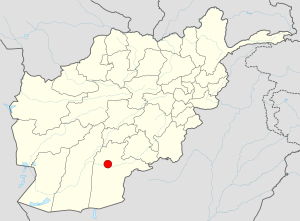
Back مجزرة قندهار Arabic Kandahar-Massaker German Masacre de Kandahar Spanish کشتار قندهار Persian Kandaharin verilöyly Finnish Massacre de Kandahar French Pembantaian Kandahar ID 칸다하르 학살 Korean Pembunuhan beramai-ramai di Panjwai Malay Masakra w Kandaharze Polish
| Kandahar massacre | |
|---|---|
 Location of the massacre in the Kandahar Province in Afghanistan | |
| Location | Panjwai District, Kandahar Province, Afghanistan |
| Coordinates | 31°31′37″N 65°29′56″E / 31.527°N 65.499°E |
| Date | 11 March 2012 03:00 AFT (UTC+04:30) |
Attack type | Triple home invasion, spree killing, mass murder |
| Weapons | M4 carbine with M203 grenade launcher and an M9 pistol. Some victims were found stabbed in addition to being shot. |
| Deaths | 16 |
| Injured | 6 |
| Victims | Afghan civilians |
| Perpetrator | Robert Bales |
The Kandahar massacre, also called the Panjwai massacre,[1] was a mass murder that occurred in the early hours of 11 March 2012, when United States Army Staff Sergeant Robert Bales murdered 16 Afghan civilians and wounded six others in the Panjwayi District of Kandahar Province, Afghanistan. Nine of his victims were children, and 11 of the dead were from the same family. Some of the corpses were partially burned. Bales was taken into custody later that morning when he told authorities, "I did it".
The U.S. and International Security Assistance Force (ISAF) authorities apologized for the deaths. Afghan authorities condemned the act, describing it as "intentional murder". The National Assembly of Afghanistan passed a resolution demanding a public trial in Afghanistan. Still, then-U.S. Secretary of Defense Leon Panetta said the soldier would be tried under U.S. military law. Bales pleaded guilty on 5 June 2013 to 16 counts of premeditated murder in exchange for the prosecution not seeking a death sentence. At the time of the plea, he said he did not know why he committed the murders. On 23 August 2013, Bales was sentenced to life in prison without the possibility of parole.[2]
United States authorities concluded that the killings were the act of a single individual. On 15 March 2012, an Afghan parliamentary probe team consisting of several members of the National Assembly of Afghanistan had speculated that up to 20 U.S. soldiers were involved in the killings. The team later said they could not confirm claims that multiple soldiers participated in the massacre.
- ^ Shah, Taimoor, "Days Of Horror And Grief: Reporting The Panjwai Massacre", New York Times, 9 November 2012
- ^ Healy, Jack (23 August 2013). "Soldier Gets Life Without Parole in Deaths of Afghan Civilians". NY Times. Archived from the original on 27 October 2014. Retrieved 23 August 2013.